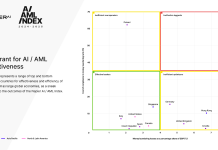In today’s evolving global financial landscape, the security and integrity of financial transactions are of utmost importance. At the heart of this security lie two critical processes: anti-money laundering (AML) and Know Your Customer (KYC).
Future-proofing client lifecycle management pioneer Fenergo has recently outlined the main different compliance processes and challenges of the duo.
Although both play a pivotal role in curtailing financial crime, they serve distinct yet interlinked functions. In this exploration, we delve into the nuanced differences between AML and KYC, their significance in the compliance framework, and best practices to maintain strong adherence to AML regulations.
AML: The Shield Against Financial Crimes
AML involves a set of measures adopted by financial institutions and other regulated entities. Its primary aim is to thwart criminals from concealing the source of their illegal funds, preventing them from integrating such funds into the legal financial stream. Key global entities like the Financial Action Task Force (FATF) provide a regulatory compass, outlining standards that institutions, particularly banks, must adhere to.
KYC: Knowing Your Customer
KYC stands as a defence mechanism that financial stalwarts, like banks, deploy against financial maleficence. Its core objective is twofold: to gather comprehensive information about customers and to ensure their risk assessment is thorough. By understanding their clientele better, these institutions can significantly mitigate risks related to financial malpractices, including money laundering, identity theft, and even terrorist financing.
Distinguishing KYC & AML
While KYC and AML share common goals, they function uniquely within the financial framework. AML can be viewed as an umbrella term, encompassing KYC and other elements, such as transaction monitoring and customer due diligence. All these components collectively contribute to a broader AML mechanism.
The Pillars of AML KYC Process
The AML KYC compliance journey involves multiple steps. These steps, which some financial institutions constantly repeat, aim to understand and verify customer identities. Key components of this dynamic process include:
- ID verification: Employing tools like biometrics, face scanning, and address verification ensures customers’ legitimacy.
- Customer due diligence (CDD): Leveraging available data to gauge the risk a customer might pose.
- Enhanced due diligence (EDD): High-risk individuals undergo rigorous checks, including credit histories and adverse media checks.
- Ongoing monitoring: Periodic evaluations and tracking unusual activities ensure up-to-date risk assessments.
- Suspicious activity reports (SAR): These reports flag potential financial crimes to law enforcement agencies.
- AML training: Keeping teams updated with the latest threats is essential for proactive defence.
Disentangling AML & KYC Compliance
While sometimes used synonymously, AML and KYC have distinct compliance paradigms. AML compliance is about an organisation’s adherence to AML-centric rules, such as the EU’s Anti-Money Laundering Directive (AMLD). These rules are designed to prevent financial misdemeanours. Conversely, KYC compliance is solely about verifying customer identities and ensuring the information they provide is genuine.
8 Best Practices to Ensure KYC AML Compliance
- Understand Regulatory Requirements: Familiarise with relevant regulations like AMLD in Europe or AMLA in the U.S.
- Develop Policies & Procedures: Ensure comprehensive guidelines for customer onboarding, monitoring, and reporting.
- Implement a Customer Identification Program (CIP): Go beyond basic identity checks with a robust CIP.
- Conduct Customer Due Diligence: Extend checks based on customer risk levels.
- Implement Transaction Monitoring Systems: Use automated systems to track suspicious activities.
- Provide Training and Awareness: Educate staff about AML and KYC best practices.
- Conduct Internal Audits: Regularly review and upgrade KYC and AML protocols.
- Stay Ahead of Industry Best Practices: Engage with industry peers and remain updated with the latest compliance standards.
The Automation Era of AML/KYC Compliance
Modern organisations often lean towards automation for KYC processes. While manual checks were the standard, digital transformation has ushered in automated tools that ensure rapid and accurate KYC checks, significantly reducing human errors and enhancing customer experience.
AML or KYC: The Compliance Verdict
For regulated institutions, AML compliance, which encompasses KYC, is mandatory. The scope varies but primarily covers financial institutions, insurance providers, high-value commodity vendors, e-money institutions, and more.
Streamlining Compliance with Fenergo
For those in quest of an automated KYC solution in 2023, Fenergo KYC is the ideal pick. Their API-first, SaaS solution offers a risk-centric approach to KYC compliance, catering to both local and global regulations.
Read the full story here.
Keep up with all the latest FinTech news here.
Copyright © 2023 FinTech Global











